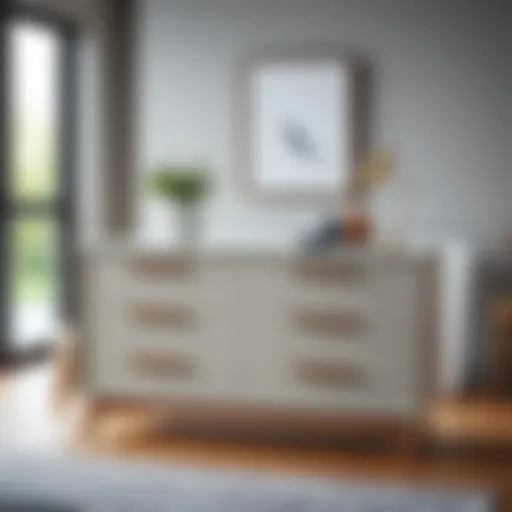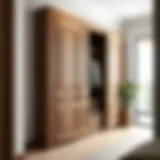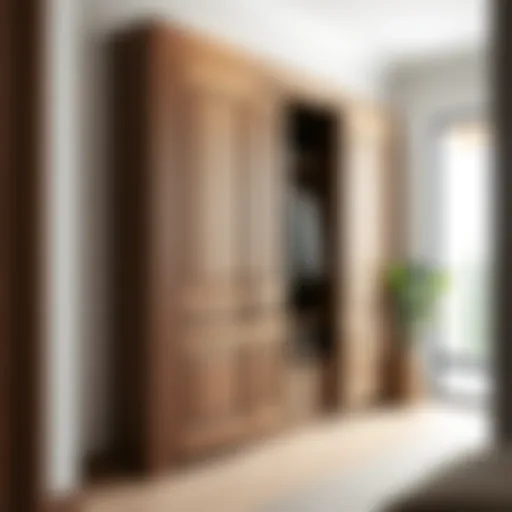Enhancing Spaces with Frosted Pantry Doors


Intro
Frosted pantry doors have emerged as an exciting element in modern interior design, bridging the gap between aesthetics and practicality. These doors, often measuring 24x80 inches, serve more than just a functional purpose; they transform mundane spaces into stylish focal points. With their unique blend of opacity and translucence, they enable light to filter through while still maintaining a degree of privacy. Homeowners, designers, and DIY enthusiasts alike are exploring the charm and versatility that frosted doors bring to kitchens, dining areas, and beyond.
In this guide, we will dive deep into the various dimensions of incorporating frosted pantry doors into your home. We will discuss current design trends, popular color palettes, installation tips, maintenance strategies, and more. By the end of this exploration, you will be equipped with the knowledge to make informed decisions that enhance both your home's style and functionality.
Furniture Trends
Current Design Trends
The current trend leans heavily toward minimalism and transparency, which fits perfectly with frosted pantry doors. Homeowners are increasingly favoring clean lines and simple designs that complement a variety of interior themes. Whether you are aiming for a chic modern look or a rustic farmhouse vibe, frosted doors can adapt seamlessly.
Many home designers are gravitating toward open shelving that showcases stylish dinnerware or canned goods while keeping clutter at bay. The elegant appearance of frosted glass allows one to display items without drawing attention to disarray behind closed doors. These doors act as a subtle boundary between spaces, allowing for a fluid transition without complete separation.
Popular Color Palettes
Color choices surrounding frosted pantry doors are as diverse as the designs themselves. Soft neutrals like whites, greys, and beiges continue to hold strong, providing a modern and airy feel to kitchens. Pairing these colors with rich wooden frames creates a warm contrast, enhancing both coziness and sophistication. On the flip side, deep blues or greens are finding their way into more adventurous palettes. These bold hues create a striking statement, inviting curiosity into the pantry area.
Here are some popular color combinations for frosted pantry doors:
- Wheat Beige with Maple Frame
- Charcoal Grey with White Oak
- Dove White with Dark Mahogany
- Seafoam Green with Natural Pine
When selecting colors, consider what will resonate with your existing decor, ensuring that the frosted doors blend seamlessly with the overall aesthetic.
Practical Tips
Furniture Maintenance and Care
Frosted pantry doors require specific care to keep them looking fresh and clean. It's essential to avoid abrasive cleaners that could scratch the surface. Instead, a soft cloth dampened with warm soapy water can effectively lift dirt and smudges. Regular upkeep involves conscious handling to prevent surface damage—especially in busy households where kids might be racing in and out.
Space Utilization Strategies
Using frosted pantry doors presents unique space utilization opportunities. Consider the areas where you can install these doors. They can be perfect for small nooks that serve as pantry spaces, making the most of every square inch in your kitchen. Opting for sliding barn-style frosted doors can also save space while creating an attractive point of interest. These doors not only fit snugly into tight corners but also harmonize well with various design styles.
Additionally, integrating ambient lighting within or around the pantry can bring out the frosted effect, adding to the overall charm of your home.
"Design is not just what it looks like and feels like. Design is how it works." - Steve Jobs
With the right approach, frosted pantry doors can redefine spaces, making them not just visually appealing but also practical. Implementing versatile strategies and thoughtful design choices invites creativity into your home. The journey of transforming a kitchen starts with understanding how key elements like frosted doors can enrich both form and function.
Prelims to Frosted Pantry Doors
When it comes to home design, aesthetics and functionality go hand in hand, like peanut butter and jelly. The frosted pantry door is one of those architectural features that not only serve a practical purpose but can also enhance the visual appeal of your living space. This section introduces you to the burgeoning trend of frosted pantry doors and the compelling reasons you might consider incorporating them into your own home.
Frosted pantry doors can be seen as the unsung heroes of interior spaces. They help create a seamless transition between rooms, providing a hint of privacy while still allowing light to filter through, which can make a room feel more open and inviting. They work particularly well in modern kitchens and can complement various design styles from minimalist to eclectic, making them a popular choice for discerning homeowners and designers alike.
Definition and Characteristics
Frosted pantry doors, as the name implies, sport a frosted glass panel that obscures views while allowing light to pass through. Typically, this glass is created by sandblasting or acid etching clear glass to achieve the desired translucency. This unique quality means that while one can see whether there are items in the pantry, the details remain hidden, lending an understated elegance to the space.
In contrast to traditional wooden doors that can feel bulky or heavy, frosted glass doors infuse a sense of lightness and sophistication. They come in various styles, including sliding, hinged, or bi-fold varieties, thus providing options that suit different spatial needs and preferences. These doors can be framed with materials like wood or metal, giving homeowners a chance to customize their look further.
Popular Dimensions and Specifications
In terms of sizing, frosted pantry doors typically adhere to the standard dimensions of 24x80 inches, though customization is often an option for those with unique spatial constraints or personal preferences. Choosing the right dimensions is critical, as it can affect both the door's functionality and its visual impact in the kitchen.
- Standard Sizes: The 24x80 inches dimension is a guardrail that fits most pantry openings, but variations can cater to taller or wider spaces.
- Thickness: Glass thickness usually ranges from 1/4 inch to 1/2 inch, balancing sturdiness with a sleek profile.
- Framing Options: Various framing materials and styles—like sleek aluminum versus rustic wood—allow customization based on your home’s decor.
By understanding these specifications and characteristics, homeowners can make informed decisions when selecting the right frosted pantry door, ensuring both beauty and utility in their home design.
Design Considerations for Frosted Pantry Doors
When it comes to making your home both functional and aesthetically pleasing, the design of your pantry doors plays a significant role. Frosted pantry doors are an intriguing choice that deserves consideration for various reasons. Not only do they provide a unique design element, but they also enhance the functionality and overall ambiance of the space.
Frosted pantry doors strike a balance between style and practicality. They serve to subtly separate spaces while allowing light to filter through, thus making narrow areas feel more spacious. The design considerations surrounding these doors are influenced by the overall architecture of your home and the specific way you plan to utilize your pantry.
Aesthetic Appeal
The aesthetic appeal of frosted pantry doors lies in their delicate yet modern aesthetic. These doors often come with a sleek and sophisticated vibe, contributing to an inviting atmosphere in a kitchen or dining area. They softly diffuse light while hiding the clutter inside the pantry, creating a seamless transition between the functional and the ornamental.
Moreover, the range of designs available—from minimalist patterns to more intricate, etched styles—enables homeowners to express their personal taste. A tastefully chosen frosted door can dramatically elevate the overall appearance of a room, lending it a touch of elegance that clear or solid wood doors might not achieve.
Integration with Various Interior Styles
Modern
A modern interior design focuses on clean lines and functionality, making frosted pantry doors an excellent companion. The simplicity of these doors aligns beautifully with contemporary spaces characterized by stark contrasts and minimalist philosophies. Their seamless appearance can expand a visual perspective—more light means brighter spaces, which is pivotal in modern design.
A unique feature of modern frosted doors is the use of geometric patterns or completely frosted glass. This not only creates a bold statement but also offers a practical solution by providing privacy while still enhancing visibility—ideal for open-plan layouts.


Rustic
Rustic interiors are all about warmth and natural materials, and frosted pantry doors can complement this aesthetic through their tactile appeal. Wood-framed frosted doors fit perfectly in rustic kitchens, where the coziness of aged textures meets the modern functionality of frosted glass.
A defining characteristic of rustic designs is their ability to blend old-world charm with new elements. Frosted doors can serve as a bridge between these two worlds, offering an updated look without losing the earthy essence that many homeowners desire. Yet, potential buyers might feel that if overdone, it could detract from the authenticity of other rustic elements in the home.
Traditional
For those leaning towards a more classical aesthetic, traditional interiors benefit from the addition of frosted pantry doors as well. Such doors can be framed in ornate woods or detailed with intricate carvings, providing a touch of sophistication. The key characteristic here is their capacity to evoke a timeless feel while incorporating modern functionality.
A unique feature of traditional frosted doors is the use of a variety of glass textures, which can enhance the decorative appeal. Homeowners appreciate that these doors blend seamlessly with the grandeur typically found in traditional design without overshadowing it. However, there's always the risk of incorporating something too contemporary that could clash with the room's overall vintage character.
Frosted pantry doors deliver versatility across different styles, showcasing how functionality and aesthetics can harmoniously coexist in home design.
Material Choices for Frosted Pantry Doors
When selecting frosted pantry doors, the material plays a pivotal role in how the door will perform and look. Picking the right materials affects durability, maintenance, and aesthetics. With options ranging from glass to wood and metal, each brings its unique characteristics to the table. Homeowners, designers, and DIY enthusiasts need to weigh these choices carefully to ensure they meet both functionality and style needs.
Types of Glass Used
Tempered Glass
Tempered glass is a common choice for frosted pantry doors, and for good reason. It undergoes a special tempering process, which enhances its strength significantly. This glass is often favored for its durability and safety. Unlike regular glass, if tempered glass breaks, it shatters into small, blunt pieces rather than sharp shards—a feature that can provide peace of mind for families with children.
Moreover, tempered glass offers excellent opacity while still allowing ambient light to diffuse. This means your pantry can be visible yet private.
Key Benefits of Tempered Glass:
- Safety: Reduced risk of injury when broken
- Durability: Better resistance to impact
- Light diffusion: Allows light without full visibility
On the downside, tempered glass can be more expensive to produce. It also requires precise cutting and fitting since it cannot be altered once tempered. Nevertheless, its strengths often outweigh the downsides, making it a popular choice.
Laminated Glass
Laminated glass is another viable option and offers a different set of features compared to tempered glass. This glass consists of two or more layers, bonded together with an interlayer. One of the standout attributes of laminated glass is its sound insulation properties, which can help in keeping the noise levels down in adjoining rooms—beneficial for quiet kitchens or dining areas.
Key Considerations for Laminated Glass:
- Enhanced security: harder to break through due to its layers
- Sound proofing: great for reducing noise from outside
- UV protection: can minimize fading of pantry contents
However, laminated glass is generally heavier and can require stronger frames to support it adequately. This aspect might not appeal to all homeowners, especially those looking for a light and airy feel in their homes.
Framing Materials
Wood
Wood framing brings a warm, inviting feel to frosted pantry doors. This material excels at blending with various design aesthetics—from cozy rustic to luxurious contemporary. One of wood’s primary benefits is its versatility; it can be painted or stained to match existing cabinetry or interior colors.
Advantages of Wood Framing:
- Customizable: various finishes can suit individual tastes
- Insulation: good thermal properties can keep food items fresher
- Longevity: with proper care, wood can last for decades
Nevertheless, wood does require regular maintenance to prevent warping or degradation, particularly in humid kitchen environments.
Metal
Choosing metal for framing offers a modern touch that stands up well against wear and tear. Often made from aluminum or steel, metal frames are known for their resilience and durability. They can create a clean, polished look that pairs nicely with frosted glass for a contemporary aesthetic.
Benefits of Metal Framing:
- Durability: more resistant to damage compared to wood
- Easy maintenance: surfaces can be cleaned easily; no paints or stains needed
- Slim profiles: can create lighter-looking structures that don’t overpower a space
However, metal can be prone to temperature fluctuations, which might lead to condensation issues. This might not be ideal in kitchens where heat and humidity are prevalent.
Composite Materials
Composite materials combine features from different substances, such as wood and plastic, to offer enhanced performance. These materials often come in a variety of textures and finishes, closely mimicking wood while being less susceptible to moisture damage.
Key Features of Composite Materials:
- Moisture resistance: less likely to warp in humid areas
- Lightweight: easier to handle and install than solid wood
- Eco-friendly options: many composites utilize recycled materials
However, composites can sometimes lack the aesthetic warmth provided by natural wood and could require specific cleaning tools to maintain their appearance.
Functionality of Frosted Pantry Doors
The role of frostet pantry doors extends far beyond aesthetics; they serve essential functional purposes that enhance not only convenience but also the overall experience within the home. An understanding of their functionality can significantly inform the decisions homeowners and designers make when it comes to integrating these doors into their living spaces.
Space Optimization
One of the standout features of frosted pantry doors is their ability to optimize space. In homes where every square inch counts, the inclusion of these doors can make a real difference.
- Illusion of Space: By using frosted glass, homeowners can create the illusion of a larger area. This type of glass allows light to flow through without creating a harsh glare, making narrow, cramped areas feel airier and less confined.
- Zone Separation with Openness: Unlike solid doors that can close off an area, frosted doors maintain a level of openness while still providing separation. This is particularly useful in open-concept spaces, where you want to distinguish the kitchen or pantry area without completely isolating it.
- Flexible Layouts: Frosted pantry doors can adapt well to varying layouts, whether the space is traditionally structured or a more unconventional design. The designs range from sliding to hinged options, offering versatility in how they can be integrated.


In practical terms, when one considers a frosted pantry door, it’s not just about closing off a section of the home – it’s about redefining how space is utilized. If you have ever stepped into a room and felt constrained by its layout, switching to frosted doors might just be the game-changer you need.
Light Diffusion and Privacy
Another crucial aspect of frosted pantry doors is the balance they strike between light diffusion and privacy, a synergy that highlights their functional appeal.
- Natural Light Flow: Frosted glass is fantastic for different environments, as it allows soft, diffused light to permeate without sacrificing privacy. This is a boon for pantries or storage areas, making them more pleasant and inviting without the harsh glare of unfiltered light.
- Maintaining Privacy: Homeowners often have their storage areas—the places where personal items and food essentials are kept—exposed to the kitchen or living room. Frosted glass ensures that the contents remain out of sight while still subtly enhancing the overall brightness of the adjacent areas.
- Balanced Atmosphere: The softening of harsh light creates a warm atmosphere which can help with the mood of the kitchen—a central point of daily activity. By balancing light and privacy, frosted doors contribute to a more welcoming environment that promotes comfort.
"Frosted pantry doors are not merely a door; they redefine how we experience and interact with our spaces."
Installation Insights for Frosted Pantry Doors
Installing frosted pantry doors can feel like threading a needle in a haystack, especially if you're not familiar with the intricacies involved. Yet, this process isn’t just about nailing a door to a frame; it’s crucial for enhancing both aesthetics and functionality in your space. A well-installed door not only looks great but also performs efficiently. Understanding the installation process can make all the difference in achieving the desired look and functionality.
Pre-Installation Considerations
Before diving headfirst into the installation, a bit of prep work goes a long way. First off, you need to assess your pantry's existing layout. Is it in a tight corner or an open space? This can influence whether you opt for a sliding mechanism or traditional hinges. Furthermore, consider your home’s overall decor—does the frosted glass door seamlessly integrate, or will it clash?
Also, take a good look at the current door frame. If it's in disrepair, you'll need to deal with that beforehand. Having all your tools at the ready, including screwdrivers, a level, and measuring tape, can save you the hassle of searching mid-install—an aggravation no one wants to face.
Step-by-Step Installation Guide
Measuring the Space
Getting your measurements right is the bread and butter of any successful installation. Accurate measurements of the space where the frosted pantry door will go ensures that you don't end up with a door that’s too small or, worse, too big. This section boils down to one simple aspect: precision. Use a measuring tape, and remember to double-check your numbers!
A popular characteristic of this task is that it requires patience—rushing is a surefire way to make mistakes. An accurate measurement can prevent headaches further down the line, especially if you have to face a return or an exchange due to sizing issues. Additionally, understanding your specific space characteristics, such as the width and height of the opening, allows for customization options.
In summary, taking the time to meticulously measure is a step that can pay dividends in the long run, ensuring a snug fit that makes the installation process smoother.
Preparing the Frame
Now that your measurements are good to go, it’s time to prep the frame. The right preparatory steps here can have a direct impact on both the installation ease and the finished appearance. A common aspect to focus on is ensuring the frame is level and free from any debris, as any flaws can lead to uneven door placement.
While some might think it’s just an aesthetic consideration, having a well-prepared frame actually affects how the door functions. A clean, well-structured frame allows for smooth door operation without the annoying squeaks or catches you might encounter otherwise.
Focus on clearing away old paint or dust. Even checking for the frame's structure is beneficial—if it’s warped or damaged, you might want to fix that first before mounting the door itself. Think of it as setting the stage for a grand performance; you wouldn’t want a shaky platform for a star show.
Mounting the Door
Finally, we arrive at the grand finale: mounting the door. This particular step is often viewed as the light at the end of the tunnel and rightly so, as it’s where everything you’ve done beforehand comes together. The characteristic that stands out here is the satisfaction of seeing your hard work transform into a visible, functional element of your home.
However, this stage requires diligence. Ensure that you use the right hardware as specified by the manufacturer—what works for one door might not for another. Installing hinges or a sliding track, depending on your choice, also means following the specifications closely to prevent future issues.
Also, be mindful of alignment; it can be tempting to skip adjustments when you’re excited to see the outcome. A misalignment here can lead to wear and tear issues over time. Finally, consider adding a handle that complements the door’s design, enhancing both its look and usability.
"The joy of seeing a beautifully installed frosted pantry door isn’t just about aesthetics; it adds a layer of functionality and personality to your space."
Maintenance and Care for Frosted Pantry Doors
Maintaining frosted pantry doors goes beyond simple aesthetics. These doors bring a unique blend of functionality and style to any kitchen, but they also demand just a touch of upkeep to keep them looking sharp and performing well over time. The investment made in these stylish fixtures warrants the diligence in their care. Regular maintenance not only prolongs their lifespan but also enhances their appearance and functionality.
The benefits of good maintenance practices are clear: they help avoid costly repairs and replacements and keep your space organized and visually appealing. Moreover, ensuring your frosted doors are well cared for can improve light diffusion and privacy—two of their main selling points.
Regular Cleaning Practices
Cleaning frosted pantry doors may seem straightforward, yet there's a bit of nuance involved to do it right. Here’s a practical approach to keep those doors spick and span:
- Use a soft cloth: When cleaning the frosted glass surfaces, find a microfiber cloth or a soft sponge. These materials won’t scratch the glass and will allow for a gentle scrub.
- Mild soap and water: Mix a few drops of mild dish soap with warm water. Dampen the cloth with this solution and wipe down the glass. Avoid strong chemicals which can cause clouding or damage.
- Wipe dry: After cleaning, use a dry cloth to remove any excess moisture or streaks.
By establishing a consistent cleaning schedule—perhaps weekly—you can ensure that stains, dust, and fingerprints don’t accumulate, which would detract from the doors' beauty and distinctive frosted texture.
Addressing Common Issues
Scratches on the Glass
One of the most common grievances with frosted pantry doors is scratches on the glass. These unsightly marks can arise from a multitude of sources—perhaps too much elbow grease during cleaning or direct impacts from daily activities. Scratches can interrupt the smooth surface of the frost, affecting light diffusion and, ultimately, privacy.
While minor scratches can be fixable—some homeowners have had success using specialized glass repair kits—larger or deeper scratches might necessitate replacing the glass. It's a good idea to consider the key characteristic of frosted glass: it hides imperfections well. This means that while scratches can be annoying, they may not always be too noticeable, depending on their location and depth.
Hinges and Hardware Care
The hinges and hardware of your frosted pantry doors are vital to their overall functionality. If these components aren’t maintained, the door may not swing or close properly, which can lead to a myriad of issues from noise to misalignment.
Regular checks are crucial. Look for signs of wear or rust, and make sure screws are properly tightened. Apply a bit of lubricant—like WD-40 or silicone spray—to keep the hinges moving smoothly. This should be done at least twice a year.
In terms of durability, proper care of hinges and hardware can extend the functional lifespan of the doors themselves. Remember, spending a few minutes on maintenance can save you the hassle of a door that won’t budge when you need to reach for your favorite spices.
"A stitch in time saves nine; a little care today can save you big headaches tomorrow."


By addressing these common issues with regular maintenance, of both the glass and its components, you can ensure your frosted pantry doors remain a delightful feature in your home.
Comparing Frosted Doors with Other Alternatives
When it comes to enhancing the look and functionality of a kitchen, frosted pantry doors offer a unique blend of style and practicality. However, making an informed choice means considering other options as well. This section delves into how frosted doors stand up against clear glass and solid wood doors, allowing homeowners, designers, and DIY enthusiasts to navigate their choices more effectively.
Clear Glass Doors
Clear glass doors are often lauded for their ability to create an illusion of space. They allow full visibility of pantry contents, which can be a double-edged sword. While one might find the aesthetic pleasing, it poses a challenge for keeping pantry items organized and tidy. A few crumbs here, a disorganized sauce bottle there, all become part of the visual experience. In contrast, frosted doors serve as a veil, softening the sight of clutter while still letting light filter through the kitchen.
Pros of Clear Glass Doors:
- Immediate visibility of contents.
- Can make small spaces appear larger.
- Classic and timeless look.
Cons of Clear Glass Doors:
- Displays pantry clutter clearly.
- Requires frequent cleaning to maintain clarity.
- May not provide sufficient privacy for some homeowners.
Frosted doors, on the other hand, provide greater privacy while maintaining a sense of brightness in the space. They also need less upkeep since fingerprints and smudges blend into the frosted finish. Plus, if you’re a culinary enthusiast with a penchant for organization, you can use opaque containers to keep the aesthetics cohesive, while enjoying the light-diffusing quality of frosted glass.
Solid Wood Doors
Solid wood doors generally exude warmth and a rustic charm that many find appealing. They can be beautifully crafted, providing heft and durability. However, solid wood comes with its share of drawbacks. For starters, weight is a major concern, as they can be cumbersome to open and close compared to lighter doors. Additionally, they tend to absorb light, making rooms feel smaller or dimmer.
Pros of Solid Wood Doors:
- Great insulation and soundproofing properties.
- Offers a warm, inviting aesthetic.
- Highly customizable with finishes and stains.
Cons of Solid Wood Doors:
- Can be pricier than alternative materials.
- Require regular maintenance to prevent warping or cracking.
- May limit visibility and light in the kitchen.
Frosted pantry doors strike a balance between the appealing features of wood and glass. They provide an inviting presence without the heaviness of solid wood and without the transparency of clear glass. Their sleek appearances can be adapted to coordinate with various styles, from sleek modern kitchens to cozy rustic spaces.
"Choosing the right pantry door can be a game changer for kitchen aesthetics and functionality."
In summary, while clear glass doors and solid wood doors each have their own merits, frosted doors offer a unique versatility. They bring light into the kitchen while minimizing the visible chaos of daily life. Ultimately, selecting a door comes down to personal preference, but knowledge of these options enhances any homeowner’s ability to make a well-rounded choice.
Cost Analysis of Frosted Pantry Doors
In any home improvement project, understanding the cost involved is crucial. When it comes to installing frosted pantry doors, being aware of the financial aspects can significantly impact a homeowner’s decision-making process. This section provides an insightful breakdown of what one can expect to pay for these alluring doors, alongside factors that contribute to their pricing. We will explore average costs and the elements that can swing the price tag from affordable to premium.
Average Pricing
The price for frosted pantry doors varies significantly based on several factors, including materials, labor, and design intricacies. Generally, homeowners can find these doors ranging from around $150 to $1,200 or more.
- Standard Models: Many manufacturers offer ready-made options that typically start at about $150 to $300. These doors often come in standard sizes and may include simple framing without extras.
- Mid-Range Options: Custom designs with moderate upgrades land between $400 to $800. This category can include decorative edges or upgraded glass types.
- Luxury Variations: High-end installations, which boast unique glass patterns or intricate frameworks, can go beyond $1,000. These doors not only serve a functional purpose but also function as a striking element in your décor.
Identifying where your budget sits in this range is important for making informed choices that fit the overall scope of your home renovations.
Factors Influencing Cost
Material Quality
When discussing Material Quality, it’s fundamental to recognize how this aspect can significantly influence the door’s overall cost. Higher quality materials not only increase durability but also enhance aesthetic appeal. Frosted pantry doors are often crafted using different types of glass, and this choice can make a world of difference.
- Tempered Glass: This type is known for its strength and safety. When broken, it shatters into small pieces rather than sharp shards, making it a popular option for homes with young children or pets. However, tempered glass typically carries a higher price tag compared to standard options.
- Laminated Glass: On the other hand, laminated glass can provide better insulation and noise reduction. Though it is slightly more expensive than tempered glass, the benefits it brings can justify the cost for many homeowners.
In summary, while higher quality materials often mean spending a bit more upfront, they typically result in longer-lasting, safer, and more visually attractive options.
Customization
The Customization aspect plays a pivotal role in pricing for frosted pantry doors. The ability to personalize your pantry door is appealing for many homeowners looking to reflect their individual tastes and harmony with interior styles.
- Unique Designs: Opting for custom sizes, unique patterns, or bespoke framing can elevate the cost considerably. Customized projects are typically crafted after specific measurements and design requirements, thus commanding a premium.
- Finishes & Hardware: Besides the appearance, choices like the finish of the frame or the quality of hardware used can affect the total price. For example, a sturdy, stylish handle made from high-grade metal will cost more than a basic plastic one.
In essence, while customization can be a financial investment, it often pays off in satisfaction and the unique character it brings to a living space.
By understanding the nuances of pricing, Homeowners can make educated decisions that align with their budget while achieving their desired aesthetic and functional results.
Epilogue
The discussion surrounding frosted pantry doors has illuminated their multifaceted role in contemporary interior design. As homeowners and designers, the choice to incorporate these doors into a space represents not only a decision anchored in practicality but also a leap into style and character that transforms mundane kitchen storage into refined aesthetics.
Summary of Key Points
- Aesthetic Value: Frosted pantry doors enhance the visual appeal of a kitchen, blending seamlessly with various interior styles—be it modern, rustic, or traditional.
- Functionality: Beyond looks, they optimize space effectively, allowing for light diffusion without compromising privacy.
- Material and Design Choices: The range of glass options—like tempered or laminated—combined with diverse framing materials, grants flexibility tailored to individual home environments.
- Installation and Maintenance: The installation process is straightforward, and with proper care, these doors promise longevity, adding value to the home.
- Cost Considerations: As discussed, understanding the cost factors—ranging from material quality to customization—enables better budgeting and planning.
"Your home should tell the story of who you are, and be a collection of what you love"
—Nate Berkus
Final Thoughts on Frosted Pantry Doors
In closing, frosted pantry doors stand out as a clever hybrid of beauty and utility. They foster a serene atmosphere in a busy space, allowing homeowners to retain a sense of order while showcasing personality through design. As we embrace more open concepts, these doors offer a chic solution for delineating spaces without closing them off entirely.
For the discerning homeowner or the innovative designer, choosing frosted pantry doors can be both a visual and practical statement—an invitation to infuse depth, light, and privacy into kitchens or any area where style matters. The journey into selecting and implementing these doors is not just about filling a need; it's about elevating the entire ambiance of a home. Whether you’re angling for that sleek look or hoping to capture a retro essence, frosted doors fit the bill, marrying form with function.
In summary, as we wrap our heads around this stylish option, it becomes clear that frosted pantry doors are not merely a trend—they are a testament to the enduring desire for homes that feel as good as they look.















